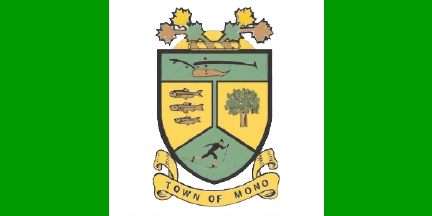 image by Ivan Sache, 26 March 2017
image by Ivan Sache, 26 March 2017
Last modified: 2022-01-29 by rob raeside
Keywords: mono | ontario |
Links: FOTW homepage |
search |
disclaimer and copyright |
write us |
mirrors
 image by Ivan Sache, 26 March 2017
image by Ivan Sache, 26 March 2017
See also:
The municipality of Mono (7,546 inhabitants in 2011; 27,778 ha) is located
just north of Caledon.
The original Township of Mono was incorporated in
1849, though mention was made as far back as 1821 in the legislation that
created Simcoe County. Simcoe County was later partitioned, along with
Wellington County, to form the County of Dufferin. In 1999 Mono changed from a
Township, officially becoming the Town of Mono on May 14th of that year.
Considerable speculation surrounds the origin of the name Mono. It is suggested
that Sir Peregrine Maitland, Lieutenant Governor of Upper Canada from 1818 to
1828, and who had served in Spain, had a fondness for foreign names, may have
named the township after the Spanish word for monkey, "mono". Some people claim
that Mono was named after a daughter of the Shawnee chief Tecumseh; however,
this interpretation has been challenged as historically inaccurate, citing that
Tecumseh only had one child, a son named Pageshashenwa. Another explanation is
that Mono was named after the Gaelic word "monadh", meaning "hilly" or
"hill-pasture".
In his book published in 1930 "Indian Place Names in Ontario", Captain
William Francis Moore further suggests that Mono may have taken its name from
the Indian word "mahnoo" meaning "let it be so". Though he does not specifically
attribute it, Moore likely took the meaning of "mahnoo" from Elijah Middlebrook
Haines' treatise on the culture and language of North American Indians titled,
"The American Indian (Un-nish-in-na-ba). The Whole Subject Complete In One
Volume" published in 1888.
http://www.townofmono.com/content/about-mono-0 - Municipal website
Ivan Sache, 26 March 2017
The flag of Mono is vertically divided green-white-green (1:2:1) with the
municipal coat of arms in the center.
Photo
http://www.townofmono.com/content/51st-anniversary-canadian-flag
The
arms of Mono were designed by Mr. William. J. Bakker in 1981 in a project
celebrating the centennial year of Dufferin County. The maple leaves at the top
are reproduced from the County of Dufferin coat of arms and signify that Mono is
one of its constituent municipalities, in addition to their symbolism of Canada
itself. The plough is a historical recognition of the farming pioneers who
settled Mono and of the continued importance of agriculture in the municipality.
The three fish represent the three major rivers whose headwaters rise in Mono:
the Credit, the Humber and the Nottawasaga, and also the abundant wildlife. The
tree represents Mono’s forests and natural beauty. The skier represents the
availability of recreational activities in Mono and the rolling terrain which
constitutes much of the landscape.
http://www.townofmono.com/content/about-mono-0 - Municipal website
Ivan Sache, 26 March 2017